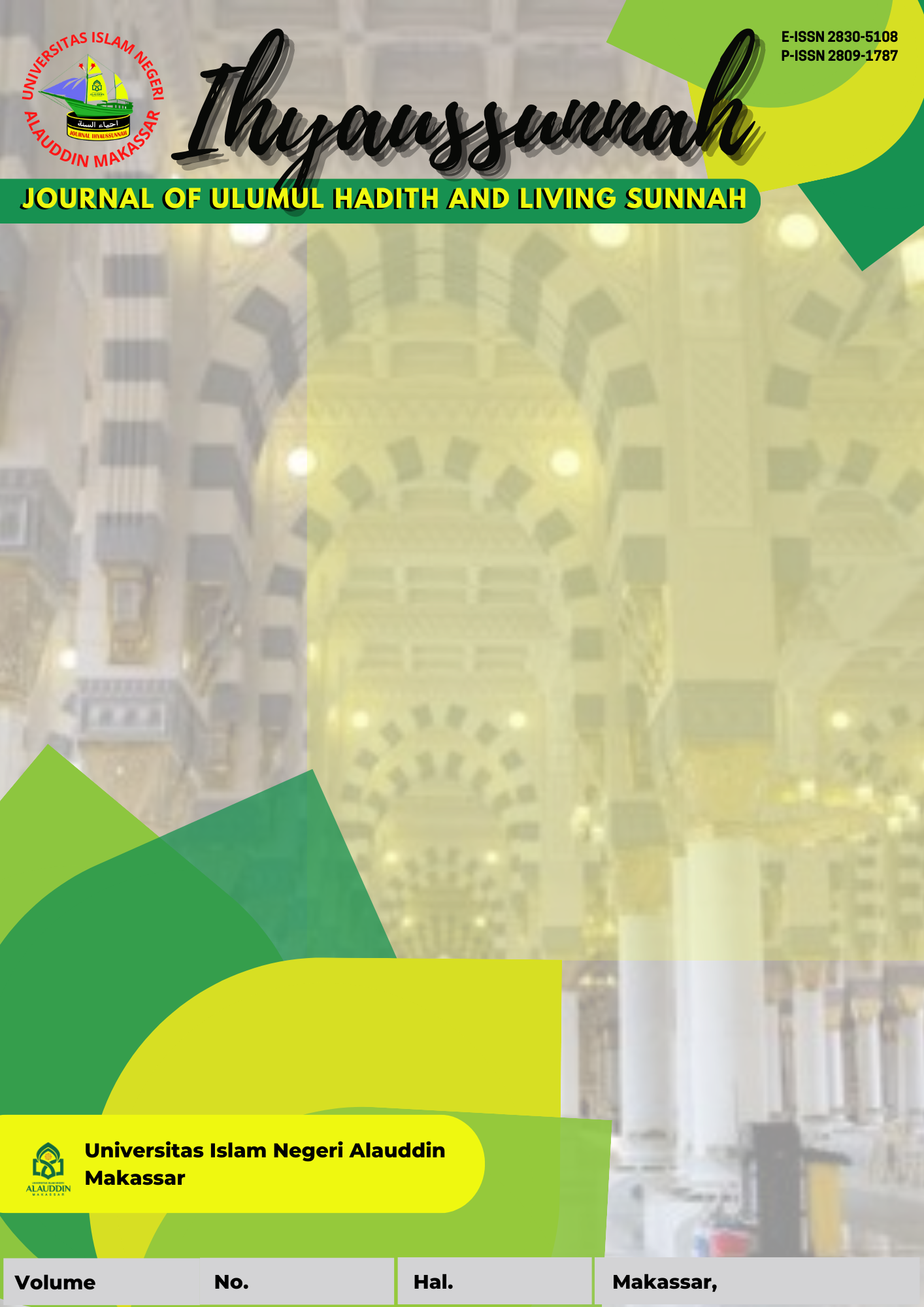Corak Pemahaman dalam Visualisasi Hadis: Studi Kasus Animasi Hadis pada Channel Youtube CulapCulip
Abstract
The rapid progress of information technology has made people make more use of online media in carrying out their daily activities. The ease of access to communication through online media makes Indonesia the country with the fourth ranking of internet users in the world. There are various social media platforms that can be used to find information, including YouTube. Apart from being a learning medium, YouTube has become a means for everyone to get the information they need from various parts of the world. Islamic Da'wah content is often found in YouTube uploads, both in the form of recordings and animations. "CulapCulip" is a YouTube channel that seeks to spread Islamic teachings using animated content. This research aims to analyze the patterns of understanding depicted in the hadith visualization by the YouTube channel "CulapCulip". This type of research is descriptive qualitative while the data analysis technique used is content analysis. This research technique is used to produce an objective and systematic description of the content contained in the YouTube channel. This research found that "CulapCulip" tries to visualize the hadiths of the Prophet with meanings that are in accordance with the reception of the understanding of hadiths in Indonesia. This research also found that "CulapCulip" attempted to visualize the Prophet's hadith contextually by considering the context of the hadith during the time of the Prophet (asbab al-wurud) and its implementation today. "CulapCulip" has succeeded in presenting a relatively new approach in providing an understanding of the Prophet's hadith in the form of animation through YouTube channel.
Downloads
References
Ahmad, Arifuddin, Amrullah Harun, and Akbar, Manajemen Ihya’ Al-Sunnah, ed. by Andi Muhammad Ali Amiruddin, Cet.1 (Depok: PT. RAJAGRAFINDO PERSADA, 2023)
Al-Bukhārī, Muḥammad bin Ismā‘īl bin Ibrāhīm bin al-Mugīrah al-Ju‘fī, Al-Jāmi‘ Al-Musnad Al-Ṣaḥīḥ Al-Mukhtaṣar Min Umūri Rasūlullah Ṣallallahu ‘Alaīhi Wasallah Wa Sunanuhū Wa Ayyāmuhū, Cet.1 (Dār Ṭūq al-Najjāh, 1422)
Al-Naisābūrī, Muslim bin al-Ḥajjāj Abū al-Ḥasan al-Qusyaīrī, Al-Musnad Al-Ṣaḥīḥ Al-Mukhtaṣar Binaql Al-‘Adl ‘an Al-‘Adl Ilā Rasūlullah Ṣallallahu ‘Alaīhi Wasallam, Cet.1 (Beirūt: Dār Iḥyā’ al-Turāṡ al-‘Arabī)
Al-Nawāwī, Abū Zakariyyā Maḥyu al-Dīn Yaḥyā bin Syarf, Al-Minhāj Syarḥ Ṣaḥīḥ Muslim Bin Al-Ḥajjāj, Cet.2 (Beirūt: Dār Iḥyā’ al-Turaṡ al-‘Arabī, 1392)
Al-Tirmiżī, Abī ‘Īsā Muḥammad bin ‘Isā bin Saurah, Al-Jāmi‘ Al-Timiżī, Cet.1 (Beirūt: Dār al-Garb al-Islāmī, 1998)
Azhari, Azhari, ‘Peran Guru Dalam Mengembangkan Kemampuan Imajinasi Terhadap Keterampilan Bercerita Pada Anak Usia Dini’, Bunayya : Jurnal Pendidikan Anak, 1.2 (2017), 93–111
Batubara, Febrin Aulia, ‘Perancangan Website Pada Pt . Ratu Enim Palembang’, REINTEK, 7.1 (2012), 15–27
CulapCulip, Azab Dan Hukum Menggambar Makhluk Bernyawa (Tashwir) (Indonesia, 2022)
———, Cicak Dalam Islam - Benarkah Harus Dihabisi? (Indonesia, 2022)
———, Dosa Bercanda Atau Main Main Dalam Sholat (Indonesia, 2021)
———, Hukum Memajang Foto Di Rumah/Kamar Dalam Islam (Indonesia, 2022)
Fadilha, Risya, ‘Resepsi Hadis Di Media Sosial Studi Kasus Film Animasi Nussa Episode Adab Menguap’, AL-MANAR: Jurnal Kajian Al-Quran Dan Hadits, 8.1 (2022), 27–42
Fikriyyah, Dliya Ul, ‘Telaah Aplikasi Hadis (Lidwa Pusaka)’, Jurnal Studi Ilmu-Ilmu Al-Qur’an Dan Hadis, 17.2 (2016), 273–88
Mulyati, Ani, Panduan Optimalisasi Media Sosial Untuk Kepentingan Perdagangan RI, ed. by Hariko Wibawa Satria and Luqman Hakim Arifin, Cet.1 (Jakarta: : Pusat Humas Kementerian Perdagangan RI, 2014)
Puyu, Darsul S., Subehan Khalik Umar, Hasdin Hanis, Bustanul Arifin, and Muhammad Abili, ‘Mansai in the Marriage Tradition of the Banggai Ethnic in Central Sulawesi, Indonesia: A Living Sunnah Perspective’, Samarah, 7.3 (2023), 1352–72
Rahmatullah, ‘Ahmad Lutfi Fathullah Dan Digitalisasi Hadith Di Nusantara’, ISLAMICA: Jurnal Studi Keislaman, 14.2 (2020), 291–316
Sasmita, Rimba Sastra, ‘Pemanfaatan Internet Sebagai Sumber Belajar’, Jurnal Pendidikan Dan Konseling, 2.1 (2020), 99–103
Stats, Internet World, ‘TOP 20 COUNTRIES WITH THE HIGHEST NUMBER OF INTERNET USERS’
Suryadi, Metode Kontemporer Memahami Hadis Nabi, ed. by Nurun Najwah, Cet.1 (Yogyakarta: Teras, 2008)
Susanti, Susi, ‘Visualisasi Hadis Dalam Film Animasi Nussa Dan Rarra Seoson 1’, Skripsi (UIN Syarif Hidayatullah Jakarta, 2023)
Syafrudin, Chabib, and Wahyu Pujiyono, ‘Pembuatan Film Animasi Pendek “ Dahsyatnya Sedekah ” Berbasis Multimedia Menggunakan Teknik 2D Hybrid Animation Dengan Pemanfaatan Graphic’, Jurnall Sarjana Teknik Informatika, 1.1 (2013), 387–98
Zain, Muhammad Izzul Haq, ‘Kontekstualisasi Hadits Larangan Menggambar Dengan Desain Grafis’, Riwayah: Jurnal Studi Hadis, 4.1 (2018), 101–24
Zuhri, Saifuddin, and Subkhani Kusuma Dewi, Living Hadis; Praktik, Resepsi, Teks, Dan Transmisi, Yogyakarta, Cet.1 (Yogyakarta: Q-MEDIA, 2018)
Copyright (c) 2024 Andi Mujahidil Ilman SM

This work is licensed under a Creative Commons Attribution-ShareAlike 4.0 International License.
Copyright
Authors who publish with IHYAUSSUNNAH JOURNAL OF ULUMUL HADITH AND LIVING SUNAH agree to the following terms:
- Authors retain copyright and grant the journal right of first publication with the work simultaneously licensed under a Creative Commons Attribution License (CC BY-SA 4.0) that allows others to share the work with an acknowledgment of the work's authorship and initial publication in this journal.
- Authors are able to enter into separate, additional contractual arrangements for the non-exclusive distribution of the journal's published version of the work (e.g., post it to an institutional repository or publish it in a book), with an acknowledgment of its initial publication in this journal.
- Authors are permitted and encouraged to post their work online (e.g., in institutional repositories or on their website) prior to and during the submission process, as it can lead to productive exchanges, as well as earlier and greater citation of published work.


